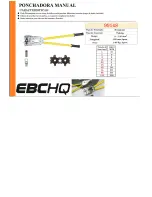
4
Instruction Manual
GB
Attention
Do not open the cutting head unless the blades
returned into their starting position. Otherwise
the cutting blades can be damaged.
Attention
Please check whether the cutting head is secu-
rely locked before starting the cutting cycle.
Attention
Dress properly. Do not wear loose clothing or
jewellery. Keep your hair, clothing and gloves
away from moving parts.
Attention
Keep proper footing and balance at all times.
Attention
Use safety gear and always wear eye protec-
tion.
4.2 Explanation of the application range
Do not cut reinforced cables/conductors with steel fortifi -
cation (e.g. pit cables, self supporting overhead cables,
sea cables, etc.).
The safety cutting unit can be operated within the tempe-
rature range of -20°C to +40°C inside and outside.
Attention
Do not operate the unit during rain.
4.3 Remarks in respect of alternative me-
ans to determine live lines
If the cable or insulated line can clearly be traced back
from the switch-off point to the cutting point, e.g. through
cable maps, markings, cable tracing equipment and other
means, it is not mandatory to check the line at the working
site if the voltage-free status has been positively determi-
ned at the switch off point.
The voltage free state at the working site must be deter-
mined with all poles. Suitable devices for determining a
voltage-free state are voltage testers.
In case it is not possible to clearly identify the voltage-free
cable or insulated line the voltage-free status must be de-
termined with the help of this safety cutting unit.
4.4 Service and Maintenance instructions
The safety cutting unit must be cleaned and dried after
each use according to EN 50110 part 1 and a dry state
must be provided before storage. Also the battery cart-
ridge (Pos.-No. 13) and the charging unit have to be pro-
tected against humidity and dust.
After each use the unit must be checked for obvious faults.
Special attention should be drawn to the insulating hose
(PPicture 1,13). The quick coupling (Picture 1,9) on the in-
sulating hose must also be examined for damages. Within
the scope of the inspection the blades (Picture 1,10) must
be checked in respect of inadmissible changes.
The electric-hydraulic cutting unit is equipped with a so-
phisticated circuit board indicating the user when the next
service is due. (Pls. read chapter 4.3 for more informati-
on) The unit must then be returned to an authorised ser-
vice center.
If the seals are damaged the warranty is invalidated.
4.5 Oil changing cycles
It is advisable to have the unit serviced by a specialist
during regular intervals to safeguard a technically proper
state before use.
Table 3 Service schedule
What?
When?
Who?
Cleaning
after each
use
Service personnel
Check connecting
devices
after each
use
Service personnel
Hochdruckschlauch
prüfen
weekly
Specialist
Hydrauliköl
wechseln
every
2 years
Manufacturer/
ASC´s
The hydraulic oil has to be completely changed after two
years or 250 cutting cycles. The oil change must be done
by the manufacturer or a specially authorized Service
Center (ASC) for this specifi c tool. Changing the oil must
be documented.
4.6 Reference as to which (spare-) parts
can be exchanged by the customers
Within the determined use of the unit the customer is only
allowed to change the blades (Picture 1,10).
Attention
Do not destroy the seals of the unit!
Do not attempt to repair the tool yourself, and do not re-
move any parts such as screws and other components.
4.7 Storage and transport of the unit
To avoid damaging the unit during transport it should al-
ways be transported in a carrying case. It must be paid
attention that the insulating hose (Picture 1,13) is properly
rolled up avoiding an extreme bending radius.
5. Troubleshooting
The hydraulic safety cutting unit is basically trouble-free.
Should nevertheless be trouble with this unit return it to
the manufacturer or contact the manufacturer for advice.
Below there is a list of possible errors and their remedy:
The cutting cycle can not be terminated properly.
=> Inform the net provider, respectively the control of-
fi ce, immediately. In case it must be assumed that the
blades have already cut into the cable special caution is
required.
Immediate action is required to cordon the working site to
avoid immediate hazards for nearby personnel.
The cable must be checked with suitable measuring
equipment by an electrician to determine the voltage sta-
tus. Only when the voltage-free state of the cable is defi -
nitely determined the cutting head can be approached.
The cutting head (Picture 1,12) is damaged during the
cutting cycle.
=> In case the cutting cycle could be completed despite
of the damage the cutting head must be returned to the
manufacturer for a damage report and repair.
Insulating fl uid is leaking.
authorised
copy
HE.13414_C © 11/2009
ESSGxxxL








































